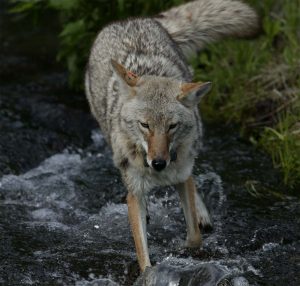Wildlife in Yellowstone
There are areas in Yellowstone that, year after year, have been my most productive spots for watching and photographing animals. Be aware that you can see almost any of Yellowstone's animals, anywhere in the park, so wherever you are, be on the lookout. Always inquire with the local park rangers/employees or other travelers about current animal viewing possibilities. The most important advice I can give you is to be out early and late in the day. The second most important advice is to look for people looking at Yellowstone’s wildlife. If most of the people in a group are all looking in the same direction, they have spotted something of interest. Use good judgment when stopping and parking along Yellowstone’s roads. Do not stop on curves and do not damage vegetation when pulling off the road. Again, drive slowly through the park and always keep a constant lookout. 
Yellowstone’s animals are wild. People are injured and or killed by many different kinds of animals in the park each year. Please do not be one of them. The Park rules are to keep at least 100 yards from bears and 25 yards from other animals. While in Yellowstone, you will probably see things that you have never imagined. Speaking from experience, under these circumstances, you must be extra careful not to throw “caution to wind.” Or as the saying around here goes, "Don’t check your brain in at the Gate.”
That said, if you are in Yellowstone long enough, you are going to find yourself in a situation with some of Yellowstone’s wildlife that you would rather not be in. How you handle yourself will determine, to a great extent, whether you and/or the animal are harmed. Since every situation will be unique, there will be many different ways to handle the particular place and setting in which you find yourself. Try not to get into these positions but, if you find yourself in one, as a general rule, first survey your surroundings and then identify any hazards that will block your escape, i.e., other animals or terrain obstructions. Then slowly back away from the animal. In spring 2010, I was hiking backcountry in Yellowstone (just 1/8 mile off a paved road) and topped a small ridge to find a griz sow and small cub only 150ft in front of me. The sow saw me but did not act aggressively. Instead she was devoting her attention to turning over rocks and watching her one cub. I started to back up, retracing my steps, while keeping my eye on the griz. As I backed down the ridge, she lost sight of me and stood up on her hind legs to find out what I was doing. Thinking I did not want the griz to come looking for me, I took two steps back up to the ridge line so that she could keep me in view and know that I was not a threat to her and her cub. Then I walked slowly away from the bear along the ridge line. She went back to turning over rocks and I moved off to a safe distance. Another time I was near the Mammoth Hotel with some friends. We had just pulled up in their car but decided not to get out because of a love-crazed bull elk that was walking around the area trying to keep up with his scattered harem of cows. We knew that he was loved-crazed because it was fall mating time. There were many people outside their cars and a few rangers trying to control the situation. Suddenly, the elk turned to a car near him and rammed his horns into the car's radiator. At that point, there was nothing the car could do; its radiator had a large hole in it. The elk had “killed” the car. Next the elk raced towards some of the people who were outside of their cars and trucks. One man did not have time to get to the door of his truck and had to dive into the bed of his pickup as the elk chased him. At this point, the elk walked away and the situation was defused. The next day as I was driving through Mammoth, I saw that same love-crazed elk minus his large antlers. The park rangers had carefully sawn them off. These are just some of the many situations you might find yourself in while in Yellowstone. Each circumstance requires different actions to defuse a perceived or real threat.
If you are serious about seeing grizzly bears, wolves and some of Yellowstone’s other wildlife, then you will want to have a spotting scope and binoculars with you. Many of your wildlife viewing opportunities will be 500 yards are more away. This is not necessarily a bad thing when viewing grizzly bears and wolves fighting over who sits at the dinner table first. Having a spotting scope will be the difference between seeing wolf pups roll about and play in front of the den or seeing three fuzzy specks in the far distance doing who knows what. You can rent both at The Silver Gate General Store, which I have owned and operated for 7 years, located conveniently near Yellowstone’s Lamar Valley, in Silver Gate, MT. You can also rent a camera for taking pictures through your scope (digiscoping) for once-in-a-lifetime photographs

